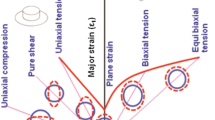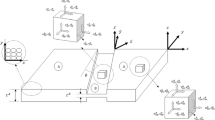Abstract
Recent work on sheet metal formability had shown that the position of forming limit diagrams (FLDs) in punch stretching is higher than that in in-plane stretching because of a strain gradient effect resulting from bending a flat sheet into a curved sheet by punch stretching. To our knowledge, none of the developed theoretical models in the study of localized necking can be used to predict this phenomenon accurately so far. In this study, a new model, using Barlat and Lian’s new nonquadratic anisotropic yield criterion, is proposed by introducing a strain gradient term in the constitutive equation to consider the effect of the first order strain gradient (curvature), in the thickness direction resulting from bending, on the localized necking in anisotropic sheets. The developed model is used to study the effects of curvature on FLDs and to predict FLDs in punch stretching and inplane stretching for various materials. It is found that the theoretical predicted results are in good agreement with experimental data.
Similar content being viewed by others
References
S.P. Keeler,Sheet Metal Ind. 42, (1965), p. 683.
G.M. Goodwin, “Application of Strain Analysis to Sheet Metal Forming Problems in the Press Shop,” SAE paper NO. 680093, (1968).
Z. Marciniak and K. Kuczynski, “Limit Strain in the Processes of Stretch-Forming Sheet Metals,”Int. J. of Mech. Sci., 9, pp. 609–620 (1967).
K.S. Chan, D.A. Koss, and A.K. Ghosh, “Localized Necking of Sheet at Negative Minor Strains,”Metall. Trans., 15A, (1984) p. 323.
D. Lee and F. Zaverl Jr., “Necking Growth and Forming Limits in Sheet Metals,”Int. J. Mech. Sci., 24, (1984) p. 157.
A. Barata Da Rocha, F. Barlat, and J.M. Minier, “Prediction of the Forming Limit Diagrams of Anisotropie Sheets in Linear and Nonlinear Loading,”Mat. Sci. Eng., 68, (1984) p. 151.
C.C. Chu, “A Three-Dimensional Model of Anisotropie Hardening in Metals and its Application to the Analysis of Sheet Metal Formability,”J. Mech. Phys. Solids, 32, (1984) pp. 197–212.
Z.H. Lu and D. Lee, “Prediction of History-Dependent Forming Limits by Applying Different Hardening Models,”Int. J. Mech. Sci., 29, (1982) pp. 123–137.
V. Tvergaard, “Effect of Kinematic Hardening on Localized Necking in Biaxially Stretched Sheets,”Int. J. Mech. Sci., 20, (1978) p. 651.
H. Van Minh, R. Sowerby, and J.C. Duncan, “Probabilistic Model of Limit Strains in Sheet Metal,”Int. J. Mech. Sci., 17, (1975) pp. 339–349.
A. Needleman and N. Triantafyllidis, “Void Growth and Local Necking in Biaxially Stretched Sheets,” ASME,J. Eng. Mater. Tech., 100, (1978) pp. 164–169.
N. Triantafyllidis and K. Samanta Shyam, “Bending Effects On Flow Localization in Metallic Sheets,” Proc. R. Soc. Lond.,A406, (1986) pp. 205–226.
P. Chen and J.C. Gerdeen, “Bending Effect on Forming Limit for Anisotropic Sheets,” inForming Limit Diagram: Concepts, Methods, and Applications, TMS, ASM, (1989).
A.K. Ghosh and S.S. Hecker, “Stretching Limits in Sheet Metals: in Plane Versus Out-of-Plane Deformations,”Met. Trans., 5, (1974) pp. 2161–2164.
P.L. Charpentier, “Influence of Punch Stretching Curvature on the Stretching Limits of Sheet Steel,”Met. Trans., 6A, (1975) pp. 1665–1669.
E.C. Aifantis, “On the Microstructural Origin of Certain Inelastic Models,” Trans. ASME,J. Eng. Mater. Tech., 106 (1984) pp. 326–330.
N. Triantafyllidis and E.C. Aifantis, “A Gradient Approach to Localization to Deformation I, Hyperelastic Material,”J. Elasticity, 16, (1986) pp. 225–237.
H.M. Zbib and E.C. Aifantis, “On the Localization and Post-Localization Behavior of Plastic Deformation I,II,III,”Res Mechanica, 23, (1988) pp. 261–277.
F. Barlat and J. Lian, “Plastic Behavior and Stretch-ability of Sheet Metals. Part I: A Yield Function for Orthotropic Sheets under Planes Stress Conditions,”Int. J. of Plast., 5, (1989) pp. 51–66.
M.F. Shi, J.C. Gerdeen, and E.C. Aifantis, “On the Coupling of Deformation Heating and Contact Friction During Strain Localization: Application to the Strip Friction Test,”Res Mechanica, in press.
R. Hill, “A Theory of the Yielding and Plastic Flow of Anisotropie Metals,” Proc. Roy. Soc. London.,Ser. A 193, (1948) p. 287.
R. Hill,Mathematical Theory of Plasticity, Oxford University Press (1950).
A.N. Bramley and P.B. Mellor, “Plastic Anisotropy of Titanium and Zinc Sheet. I. Macroscopic Approach,”Int. J. Mech. Sci., 10, (1968) p. 211.
R.M.S.B. Horta, W.T. Roberts, and D.V. Wilson, “Effects of Plastic Anisotropy on the Biaxial Stretching Performance of Low-Carbon Steels,”Int. J. Mech. Sci., 12, (1970) pp. 231–243.
R. Pearce, “Some Aspects of Anisotropic Plasticity in Sheet Metals,”Int. J. Mech. Sci., 10, (1968) p. 995.
P.B. Mellor and A. Parmar, “Plasticity Analysis of Sheet Metal Forming,” inMechanics of Sheet Metal Forming, eds., D.P. Koistinen and N-M Wang, (1978) pp. 53–74.
R. Hill, “Theoretical Plasticity of Textured Aggregates,” Math. Proc. Comb. Phil. Soc.85, (1979) p. 179.
Y. Zhu, B. Dodd, R.M. Caddell, and W.F. Hosford, “Limitation of Hill’s 1979 Anisotropic Yield Criterion,”Int. J. Mech. Sci., 29, (1987) pp. 733–741.
W.F. Hosford, “On Yield Loci of Anisotropic Cubic Metals,” Proc. 7th North Amer. Metalworking Conf. SME, Dearborn, Michigan, (1979) p. 191.
E. Chu, M.F. Shi, and J.C. Gerdeen, “Certain Aspects of the Limiting Drawing Ratio in Sheet Metal Forming Processes,” Proc. 15th IDDRG Conf., SME, (1988) pp. 171–176.
J.C. Gerdeen, “Development of a Computer Program “AXIFORM” for the Analysis of Forming of Axisymmetric Sheet Metal Parts,” Proc. NAMRC-XII, SME Trans., (1984) pp. 209–213.
R. Hill, “On Discontinuous Plastic States with the Special Reference to Localized Necking in Thin Sheets,”J. Mech. Phys. Solids, 1, (1952) pp. 19–30.
J. Lian and B. Baudelet, “Forming Limit Diagram of Sheet Metal in the Negative Minor Strain Region,”Mat. Sci. Engng., 86 (1987) pp. 137–144.
S.S. Hecker, “Experimental Studies of Sheet Stretch-ability,” inFormability: Analysis, Modelling and Experimentation, eds., S.S. Hecker, A.K. Ghosh, and H.L. Gegel, (1977) pp. 150–182.
S.S. Hecker, “Formability of HSLA Steel Sheets,”Met. Eng. Quart., 13 (1973) pp. 42–48.
S.S. Hecker, “Simple Technique for Determining Forming Limit Curves,”Sheet Metel Indus., 48 (1975) pp. 671–676.
G. LeRoy and J.D. Embury, “The Utilisation of Failure Maps to Compare the Fracture Modes Occurring in Aluminum Alloys,” inFormability: Analysis, Modelling and Experimentation, eds., S.S. Hecker, A.K. Ghosh, and H.L. Gegel, (1977) pp. 183–207.
A.K. Tadros and P.B. Mellor, “An Experimental Study of the In-plane Stretching of Sheet Metal,”Int. J. Mech. Sci., 20, (1978) pp. 121–134.
Author information
Authors and Affiliations
Rights and permissions
About this article
Cite this article
Shi, M.F., Gerdeen, J.C. Effect of strain gradient and curvature on forming limit diagrams for anisotropic sheets. J. Materials Shaping Technology 9, 253–268 (1991). https://doi.org/10.1007/BF02833650
Issue Date:
DOI: https://doi.org/10.1007/BF02833650




